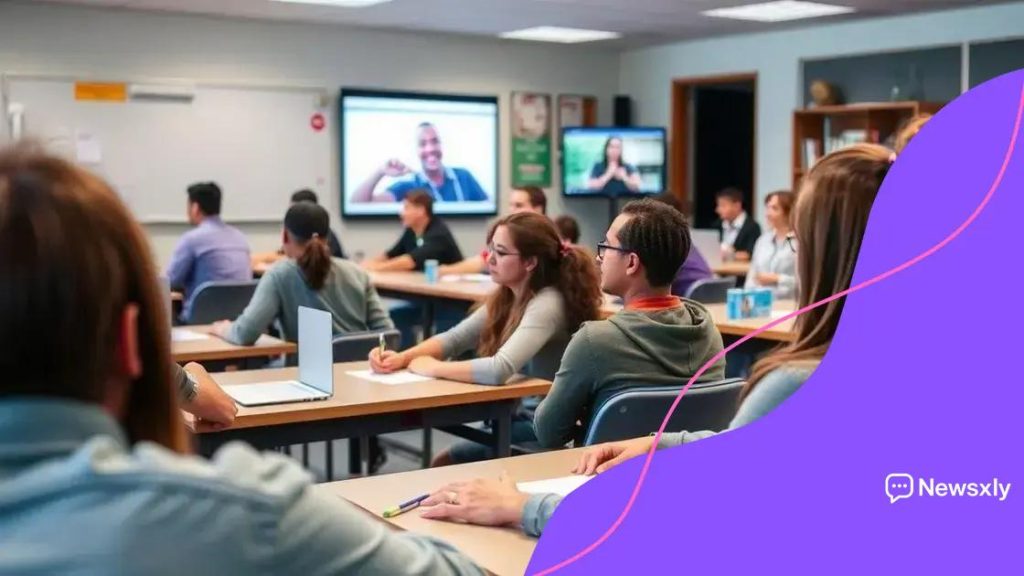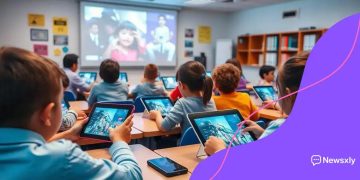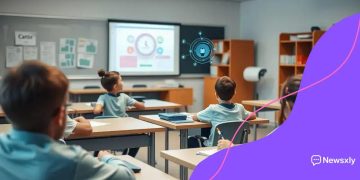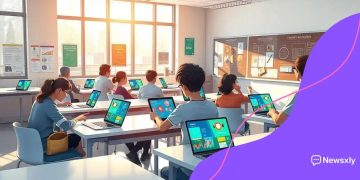Hybrid learning effectiveness: unlock your potential

Hybrid learning effectiveness refers to the optimal integration of in-person and online education, enhancing flexibility and engagement while enabling personalized learning experiences through the use of technology and ongoing assessments.
Hybrid learning effectiveness is gaining traction as a transformative approach to education. Have you considered how this method could enhance your learning journey?
Understanding hybrid learning
Understanding hybrid learning is essential in today’s educational landscape. It blends traditional in-person instruction with online learning, offering flexibility and accessibility for students.
This approach creates a rich learning environment. Students can benefit from the best of both worlds, engaging with instructors face-to-face while also having the option to explore resources online.
Benefits of hybrid learning
Hybrid learning has several advantages that make it appealing to both educators and students. These include:
- Flexibility in learning schedules.
- Access to a wide range of resources and materials.
- Improved student engagement through diverse teaching methods.
Moreover, this model fosters independence in students. They learn how to manage their time effectively and take responsibility for their education. With online components, they can revisit lessons at their own pace, ensuring they grasp the material thoroughly.
Engagement Strategies
To enhance student interaction in a hybrid setting, educators can implement various strategies. One such strategy is the use of interactive online platforms that enable real-time discussions.
- Incorporating multimedia resources such as videos, podcasts, and interactive quizzes can boost engagement.
- Encouraging collaborative projects among students helps build community and teamwork skills.
- Regular feedback from instructors can guide students and keep them motivated.
Also, ensuring that students have a clear understanding of expectations helps maintain accountability. When procedures are straightforward, learners are more likely to participate actively.
Key benefits of hybrid learning
One of the main advantages of hybrid learning is its ability to combine flexibility with structure. This model allows students to learn at their own pace while still benefiting from guided instruction.
Hybrid learning provides students with the opportunity to choose how and when they study. They can attend classes in person for hands-on experiences and access online materials for additional learning. This blend helps cater to different learning styles.
Increased Accessibility
Another important benefit is increased accessibility. Students can engage from anywhere, provided they have internet access. This flexibility allows those with various commitments—like jobs or family responsibilities—to participate fully.
- Students with disabilities find it easier to navigate learning resources.
- Online access opens doors for students who may be geographically isolated.
- Alternative scheduling accommodates those needing evening or weekend classes.
Moreover, this model fosters a sense of ownership in students. They learn to manage their time and resources more effectively, becoming more independent as learners. This independence can enhance their motivation and engagement.
Enhanced Collaboration
Hybrid learning encourages collaboration among students. They can work together on group projects, even if they are in different locations. Technology facilitates these connections.
- Video conferencing tools allow for real-time discussions.
- Collaborative platforms enable students to share ideas and resources seamlessly.
- Feedback from peers and instructors can be shared instantly, promoting continuous improvement.
By enhancing collaboration, hybrid learning prepares students for a future where teamwork and communication are crucial job skills. Students become adept at using technology for various purposes, gaining confidence and competence in navigating digital environments.
Effective strategies for hybrid learning

Effective strategies for hybrid learning are crucial for maximizing student engagement and success. By integrating various teaching methods, educators can create a dynamic learning environment.
One key strategy is to develop a structured schedule that balances both in-person and online activities. This helps students anticipate what to expect each week, making it easier for them to plan their studies.
Utilizing Technology
Technology plays a central role in making hybrid learning effective. Using platforms that support interactive learning can enhance student participation.
- Employ learning management systems (LMS) to organize resources and assignments.
- Incorporate tools like video conferencing to facilitate real-time discussions.
- Use engaging multimedia content to capture student interest.
These technological tools can keep the lessons lively, encouraging students to participate actively, regardless of their location.
Encouraging Collaboration
Another effective approach is fostering collaboration among students. Group projects can bridge the gap between in-class and online learners.
- Create small groups that mix in-person and remote students.
- Encourage peer feedback on assignments to build a sense of community.
- Host virtual study sessions to allow students to share insights and ideas.
Such collaborative efforts can enhance learning experiences and help build connections among students, regardless of their physical presence.
Additionally, regular check-ins with both in-person and online students help maintain a connection. This practice ensures everyone feels supported and included. Educators can ask for feedback to continuously improve the hybrid learning experience.
Technology tools for hybrid learning
Technology tools are the backbone of hybrid learning. They provide the resources necessary to create engaging and effective learning environments that blend in-person and online education.
First, using a learning management system (LMS) is essential. An LMS allows teachers to organize course materials, assignments, and grades all in one place.
Key Features of an LMS
An effective LMS can enhance both teaching and learning experiences. Here are some features that make it valuable:
- Centralized access to course materials.
- Real-time messaging and communication tools.
- Assessment tools for quizzes and assignments.
These features not only save time but also create a more organized approach to learning. Important information remains easily accessible, facilitating smoother communication between students and teachers.
Video Conferencing Tools
Another critical component of hybrid learning is video conferencing tools. Platforms like Zoom or Microsoft Teams enable live classes where interaction is possible.
- They allow students to ask questions in real-time, fostering engagement.
- Recording capabilities enable students to revisit past classes for better understanding.
- Breakout rooms facilitate group discussions, enhancing collaboration.
These tools help bridge the gap between remote and in-person learners. Students feel more connected, sharing ideas and resources regardless of their location.
In addition to these tools, incorporating interactive resources like virtual whiteboards and polling software can enhance engagement. These resources make online participation more dynamic, allowing students to contribute to discussions actively.
Overall, the right technology tools can significantly improve the effectiveness of hybrid learning. They empower both students and teachers, ensuring a more inclusive and exciting educational experience.
Measuring the effectiveness of hybrid learning
Measuring the effectiveness of hybrid learning is crucial to understanding how well this educational model works. By evaluating various factors, educators can improve their teaching strategies and enhance student outcomes.
To assess effectiveness, the first step is to collect data on student performance. This can include grades, test scores, and participation rates. Analyzing this data helps identify areas where students excel or struggle.
Feedback and Surveys
Collecting feedback from students is another effective way to measure success. Surveys can provide valuable insights into their experiences.
- Ask students how comfortable they feel with the technology used.
- Inquire if they find the class structure helpful for their learning.
- Gather input on what they enjoy or what challenges they face.
These surveys can lead to actionable changes that improve the hybrid learning experience.
Engagement Metrics
Tracking engagement metrics is vital in understanding the impact of hybrid learning. High engagement levels often correlate with better learning outcomes.
- Monitor attendance in both in-person and online sessions.
- Analyze participation in discussions and group work.
- Evaluate the frequency of resource usage, such as online materials and assignments.
Engagement metrics help gauge students’ connection to the material. When students are actively involved, they are more likely to succeed.
Additionally, using standardized assessments can provide an objective measure of learning outcomes. Comparing results before and after implementing a hybrid model can show its effectiveness clearly. By continuously measuring these factors, educators can adapt their approaches for better student success.
FAQ – Frequently Asked Questions about Hybrid Learning
What is hybrid learning?
Hybrid learning combines traditional in-person classroom experiences with online learning opportunities, allowing for flexibility and accessibility.
How can technology enhance hybrid learning?
Technology tools like learning management systems and video conferencing platforms can facilitate communication and make learning interactive.
Why is measuring effectiveness important?
Measuring effectiveness helps educators identify areas for improvement and ensures that students are benefiting from the hybrid learning model.
How can feedback from students be used?
Student feedback can be collected through surveys to understand their experiences and make adjustments to enhance the learning environment.





